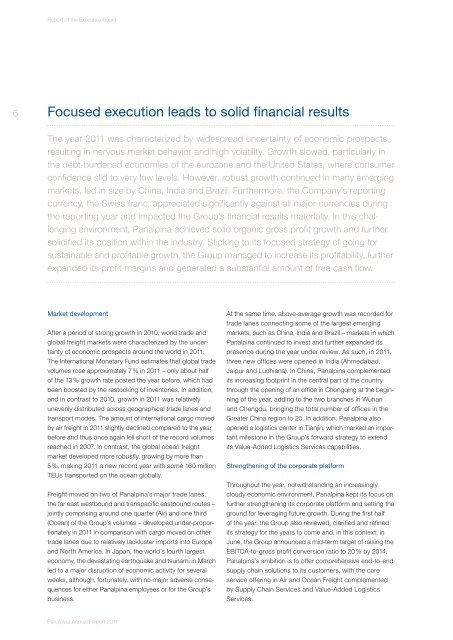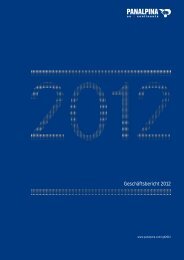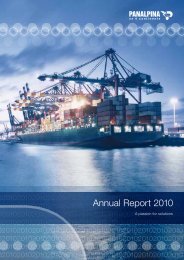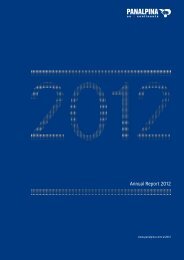Panalpina Annual Report 2011
Panalpina Annual Report 2011
Panalpina Annual Report 2011
Create successful ePaper yourself
Turn your PDF publications into a flip-book with our unique Google optimized e-Paper software.
6<br />
<strong>Report</strong> of the Executive Board<br />
Focused execution leads to solid financial results<br />
The year <strong>2011</strong> was characterized by widespread uncertainty of economic prospects,<br />
resulting in nervous market behavior and high volatility. Growth slowed, particularly in<br />
the debt-burdened economies of the eurozone and the United States, where consumer<br />
confidence slid to very low levels. However, robust growth continued in many emerging<br />
markets, led in size by China, India and Brazil. Furthermore, the Company’s reporting<br />
currency, the Swiss franc, appreciated significantly against all major currencies during<br />
the reporting year and impacted the Group’s financial results materially. In this challenging<br />
environment, <strong>Panalpina</strong> achieved solid organic gross profit growth and further<br />
solidified its position within the industry. Sticking to its focused strategy of going for<br />
sustainable and profitable growth, the Group managed to increase its profitability, further<br />
expanded its profit margins and generated a substantial amount of free cash flow.<br />
Market development<br />
After a period of strong growth in 2010, world trade and<br />
global freight markets were characterized by the uncertainty<br />
of economic prospects around the world in <strong>2011</strong>.<br />
The International Monetary Fund estimates that global trade<br />
volumes rose approximately 7 % in <strong>2011</strong> – only about half<br />
of the 13 % growth rate posted the year before, which had<br />
been boosted by the restocking of inventories. In addition,<br />
and in contrast to 2010, growth in <strong>2011</strong> was relatively<br />
unevenly distributed across geographical trade lanes and<br />
transport modes. The amount of international cargo moved<br />
by air freight in <strong>2011</strong> slightly declined compared to the year<br />
before and thus once again fell short of the record volumes<br />
reached in 2007. In contrast, the global ocean freight<br />
market developed more robustly, growing by more than<br />
5 %, making <strong>2011</strong> a new record year with some 160 million<br />
TEUs transported on the ocean globally.<br />
Freight moved on two of <strong>Panalpina</strong>’s major trade lanes,<br />
the far east westbound and transpacific eastbound routes –<br />
jointly comprising around one quarter (Air) and one third<br />
(Ocean) of the Group’s volumes – developed under-proportionately<br />
in <strong>2011</strong> in comparison with cargo moved on other<br />
trade lanes due to relatively lackluster imports into Europe<br />
and North America. In Japan, the world’s fourth largest<br />
economy, the devastating earthquake and tsunami in March<br />
led to a major disruption of economic activity for several<br />
weeks, although, fortunately, with no major adverse consequences<br />
for either <strong>Panalpina</strong> employees or for the Group’s<br />
business.<br />
<strong>Panalpina</strong> <strong>Annual</strong> <strong>Report</strong> <strong>2011</strong><br />
At the same time, above-average growth was recorded for<br />
trade lanes connecting some of the largest emerging<br />
markets, such as China, India and Brazil – markets in which<br />
<strong>Panalpina</strong> continued to invest and further expanded its<br />
presence during the year under review. As such, in <strong>2011</strong>,<br />
three new offices were opened in India (Ahmedabad,<br />
Jaipur and Ludhiana). In China, <strong>Panalpina</strong> complemented<br />
its increasing footprint in the central part of the country<br />
through the opening of an office in Chongqing at the beginning<br />
of the year, adding to the two branches in Wuhan<br />
and Chengdu, bringing the total number of offices in the<br />
Greater China region to 20. In addition, <strong>Panalpina</strong> also<br />
opened a logistics center in Tianjin, which marked an important<br />
milestone in the Group’s forward strategy to extend<br />
its Value-Added Logistics Services capabilities.<br />
Strengthening of the corporate platform<br />
Throughout the year, notwithstanding an increasingly<br />
cloudy economic environment, <strong>Panalpina</strong> kept its focus on<br />
further strengthening its corporate platform and setting the<br />
ground for leveraging future growth. During the first half<br />
of the year, the Group also reviewed, clarified and refined<br />
its strategy for the years to come and, in this context, in<br />
June, the Group announced a mid-term target of raising the<br />
EBITDA-to-gross profit conversion ratio to 20 % by 2014.<br />
<strong>Panalpina</strong>’s ambition is to offer comprehensive end-to-end<br />
supply chain solutions to its customers, with the core<br />
service offering in Air and Ocean Freight complemented<br />
by Supply Chain Services and Value-Added Logistics<br />
Services.






